Assignment Essay Business in Emerging Market
VerifiedAdded on 2020/04/15
|9
|3530
|31
AI Summary
Contribute Materials
Your contribution can guide someone’s learning journey. Share your
documents today.
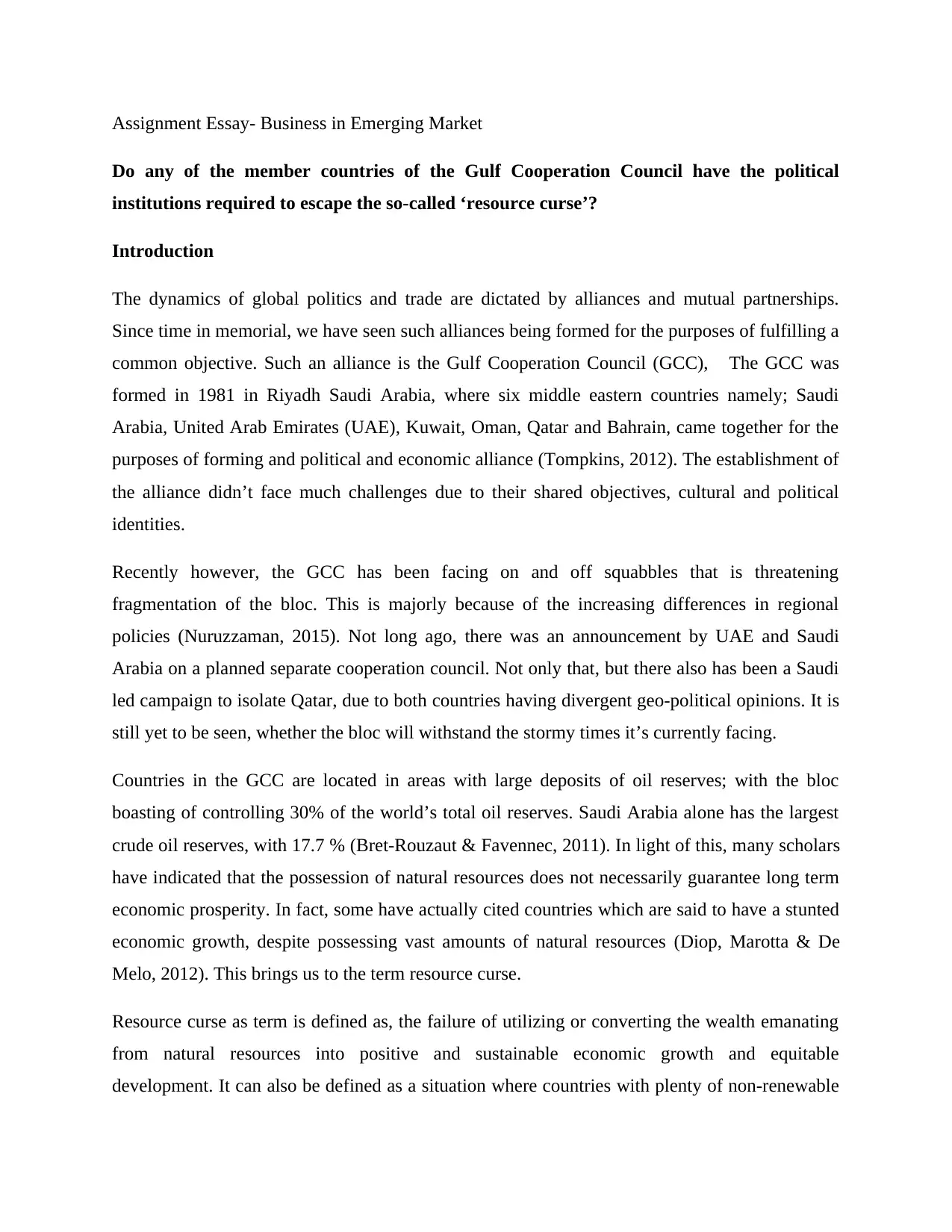
Assignment Essay- Business in Emerging Market
Do any of the member countries of the Gulf Cooperation Council have the political
institutions required to escape the so-called ‘resource curse’?
Introduction
The dynamics of global politics and trade are dictated by alliances and mutual partnerships.
Since time in memorial, we have seen such alliances being formed for the purposes of fulfilling a
common objective. Such an alliance is the Gulf Cooperation Council (GCC), The GCC was
formed in 1981 in Riyadh Saudi Arabia, where six middle eastern countries namely; Saudi
Arabia, United Arab Emirates (UAE), Kuwait, Oman, Qatar and Bahrain, came together for the
purposes of forming and political and economic alliance (Tompkins, 2012). The establishment of
the alliance didn’t face much challenges due to their shared objectives, cultural and political
identities.
Recently however, the GCC has been facing on and off squabbles that is threatening
fragmentation of the bloc. This is majorly because of the increasing differences in regional
policies (Nuruzzaman, 2015). Not long ago, there was an announcement by UAE and Saudi
Arabia on a planned separate cooperation council. Not only that, but there also has been a Saudi
led campaign to isolate Qatar, due to both countries having divergent geo-political opinions. It is
still yet to be seen, whether the bloc will withstand the stormy times it’s currently facing.
Countries in the GCC are located in areas with large deposits of oil reserves; with the bloc
boasting of controlling 30% of the world’s total oil reserves. Saudi Arabia alone has the largest
crude oil reserves, with 17.7 % (Bret-Rouzaut & Favennec, 2011). In light of this, many scholars
have indicated that the possession of natural resources does not necessarily guarantee long term
economic prosperity. In fact, some have actually cited countries which are said to have a stunted
economic growth, despite possessing vast amounts of natural resources (Diop, Marotta & De
Melo, 2012). This brings us to the term resource curse.
Resource curse as term is defined as, the failure of utilizing or converting the wealth emanating
from natural resources into positive and sustainable economic growth and equitable
development. It can also be defined as a situation where countries with plenty of non-renewable
Do any of the member countries of the Gulf Cooperation Council have the political
institutions required to escape the so-called ‘resource curse’?
Introduction
The dynamics of global politics and trade are dictated by alliances and mutual partnerships.
Since time in memorial, we have seen such alliances being formed for the purposes of fulfilling a
common objective. Such an alliance is the Gulf Cooperation Council (GCC), The GCC was
formed in 1981 in Riyadh Saudi Arabia, where six middle eastern countries namely; Saudi
Arabia, United Arab Emirates (UAE), Kuwait, Oman, Qatar and Bahrain, came together for the
purposes of forming and political and economic alliance (Tompkins, 2012). The establishment of
the alliance didn’t face much challenges due to their shared objectives, cultural and political
identities.
Recently however, the GCC has been facing on and off squabbles that is threatening
fragmentation of the bloc. This is majorly because of the increasing differences in regional
policies (Nuruzzaman, 2015). Not long ago, there was an announcement by UAE and Saudi
Arabia on a planned separate cooperation council. Not only that, but there also has been a Saudi
led campaign to isolate Qatar, due to both countries having divergent geo-political opinions. It is
still yet to be seen, whether the bloc will withstand the stormy times it’s currently facing.
Countries in the GCC are located in areas with large deposits of oil reserves; with the bloc
boasting of controlling 30% of the world’s total oil reserves. Saudi Arabia alone has the largest
crude oil reserves, with 17.7 % (Bret-Rouzaut & Favennec, 2011). In light of this, many scholars
have indicated that the possession of natural resources does not necessarily guarantee long term
economic prosperity. In fact, some have actually cited countries which are said to have a stunted
economic growth, despite possessing vast amounts of natural resources (Diop, Marotta & De
Melo, 2012). This brings us to the term resource curse.
Resource curse as term is defined as, the failure of utilizing or converting the wealth emanating
from natural resources into positive and sustainable economic growth and equitable
development. It can also be defined as a situation where countries with plenty of non-renewable
Secure Best Marks with AI Grader
Need help grading? Try our AI Grader for instant feedback on your assignments.
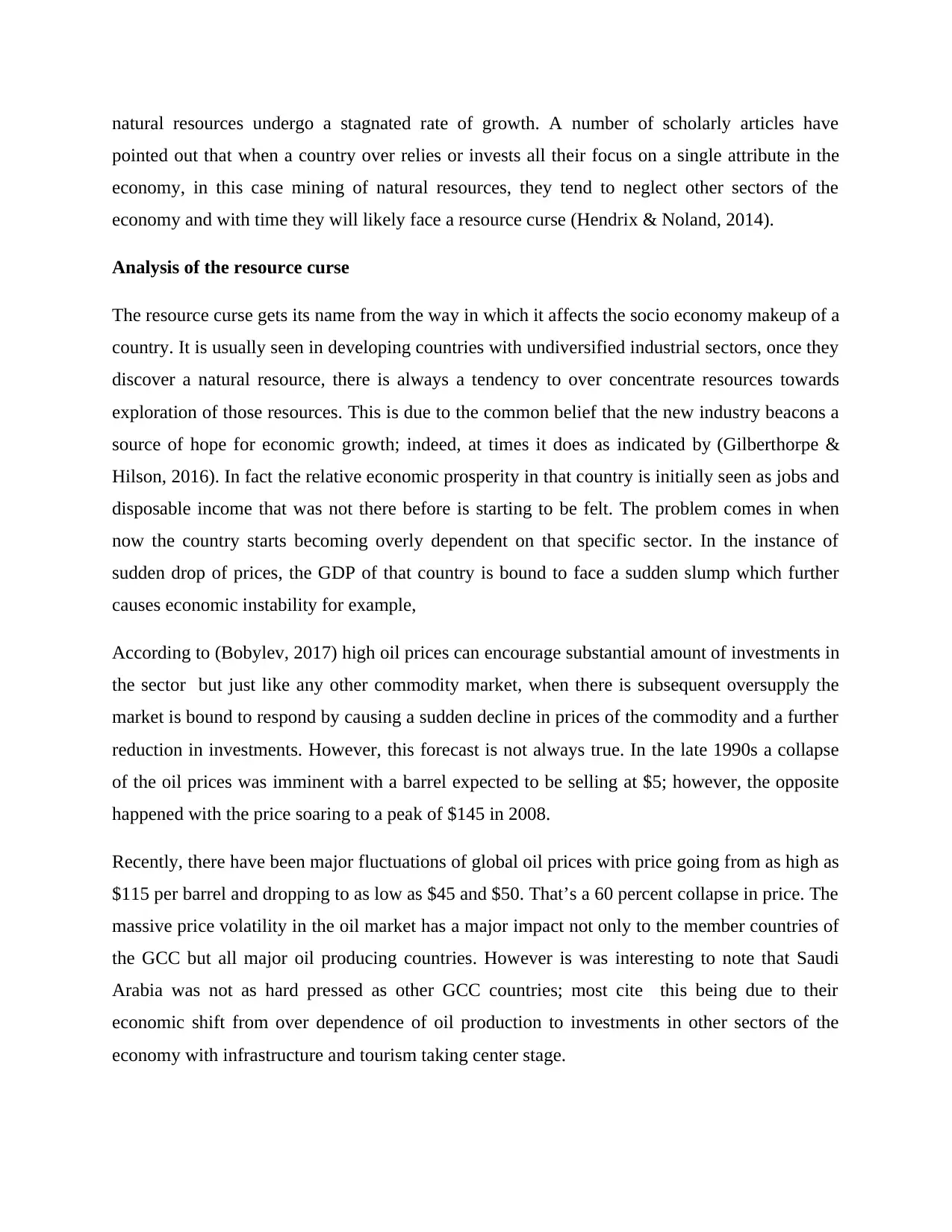
natural resources undergo a stagnated rate of growth. A number of scholarly articles have
pointed out that when a country over relies or invests all their focus on a single attribute in the
economy, in this case mining of natural resources, they tend to neglect other sectors of the
economy and with time they will likely face a resource curse (Hendrix & Noland, 2014).
Analysis of the resource curse
The resource curse gets its name from the way in which it affects the socio economy makeup of a
country. It is usually seen in developing countries with undiversified industrial sectors, once they
discover a natural resource, there is always a tendency to over concentrate resources towards
exploration of those resources. This is due to the common belief that the new industry beacons a
source of hope for economic growth; indeed, at times it does as indicated by (Gilberthorpe &
Hilson, 2016). In fact the relative economic prosperity in that country is initially seen as jobs and
disposable income that was not there before is starting to be felt. The problem comes in when
now the country starts becoming overly dependent on that specific sector. In the instance of
sudden drop of prices, the GDP of that country is bound to face a sudden slump which further
causes economic instability for example,
According to (Bobylev, 2017) high oil prices can encourage substantial amount of investments in
the sector but just like any other commodity market, when there is subsequent oversupply the
market is bound to respond by causing a sudden decline in prices of the commodity and a further
reduction in investments. However, this forecast is not always true. In the late 1990s a collapse
of the oil prices was imminent with a barrel expected to be selling at $5; however, the opposite
happened with the price soaring to a peak of $145 in 2008.
Recently, there have been major fluctuations of global oil prices with price going from as high as
$115 per barrel and dropping to as low as $45 and $50. That’s a 60 percent collapse in price. The
massive price volatility in the oil market has a major impact not only to the member countries of
the GCC but all major oil producing countries. However is was interesting to note that Saudi
Arabia was not as hard pressed as other GCC countries; most cite this being due to their
economic shift from over dependence of oil production to investments in other sectors of the
economy with infrastructure and tourism taking center stage.
pointed out that when a country over relies or invests all their focus on a single attribute in the
economy, in this case mining of natural resources, they tend to neglect other sectors of the
economy and with time they will likely face a resource curse (Hendrix & Noland, 2014).
Analysis of the resource curse
The resource curse gets its name from the way in which it affects the socio economy makeup of a
country. It is usually seen in developing countries with undiversified industrial sectors, once they
discover a natural resource, there is always a tendency to over concentrate resources towards
exploration of those resources. This is due to the common belief that the new industry beacons a
source of hope for economic growth; indeed, at times it does as indicated by (Gilberthorpe &
Hilson, 2016). In fact the relative economic prosperity in that country is initially seen as jobs and
disposable income that was not there before is starting to be felt. The problem comes in when
now the country starts becoming overly dependent on that specific sector. In the instance of
sudden drop of prices, the GDP of that country is bound to face a sudden slump which further
causes economic instability for example,
According to (Bobylev, 2017) high oil prices can encourage substantial amount of investments in
the sector but just like any other commodity market, when there is subsequent oversupply the
market is bound to respond by causing a sudden decline in prices of the commodity and a further
reduction in investments. However, this forecast is not always true. In the late 1990s a collapse
of the oil prices was imminent with a barrel expected to be selling at $5; however, the opposite
happened with the price soaring to a peak of $145 in 2008.
Recently, there have been major fluctuations of global oil prices with price going from as high as
$115 per barrel and dropping to as low as $45 and $50. That’s a 60 percent collapse in price. The
massive price volatility in the oil market has a major impact not only to the member countries of
the GCC but all major oil producing countries. However is was interesting to note that Saudi
Arabia was not as hard pressed as other GCC countries; most cite this being due to their
economic shift from over dependence of oil production to investments in other sectors of the
economy with infrastructure and tourism taking center stage.
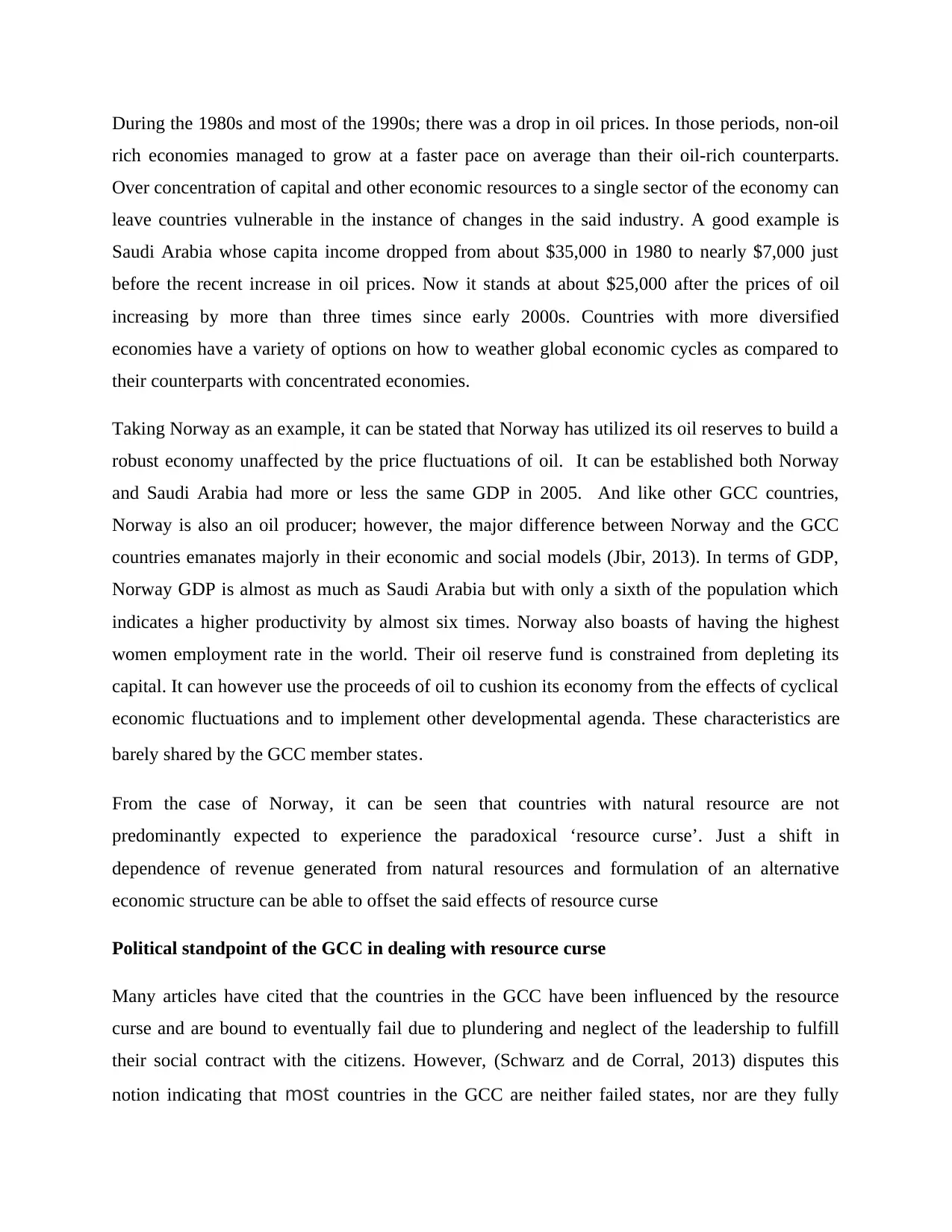
During the 1980s and most of the 1990s; there was a drop in oil prices. In those periods, non-oil
rich economies managed to grow at a faster pace on average than their oil-rich counterparts.
Over concentration of capital and other economic resources to a single sector of the economy can
leave countries vulnerable in the instance of changes in the said industry. A good example is
Saudi Arabia whose capita income dropped from about $35,000 in 1980 to nearly $7,000 just
before the recent increase in oil prices. Now it stands at about $25,000 after the prices of oil
increasing by more than three times since early 2000s. Countries with more diversified
economies have a variety of options on how to weather global economic cycles as compared to
their counterparts with concentrated economies.
Taking Norway as an example, it can be stated that Norway has utilized its oil reserves to build a
robust economy unaffected by the price fluctuations of oil. It can be established both Norway
and Saudi Arabia had more or less the same GDP in 2005. And like other GCC countries,
Norway is also an oil producer; however, the major difference between Norway and the GCC
countries emanates majorly in their economic and social models (Jbir, 2013). In terms of GDP,
Norway GDP is almost as much as Saudi Arabia but with only a sixth of the population which
indicates a higher productivity by almost six times. Norway also boasts of having the highest
women employment rate in the world. Their oil reserve fund is constrained from depleting its
capital. It can however use the proceeds of oil to cushion its economy from the effects of cyclical
economic fluctuations and to implement other developmental agenda. These characteristics are
barely shared by the GCC member states.
From the case of Norway, it can be seen that countries with natural resource are not
predominantly expected to experience the paradoxical ‘resource curse’. Just a shift in
dependence of revenue generated from natural resources and formulation of an alternative
economic structure can be able to offset the said effects of resource curse
Political standpoint of the GCC in dealing with resource curse
Many articles have cited that the countries in the GCC have been influenced by the resource
curse and are bound to eventually fail due to plundering and neglect of the leadership to fulfill
their social contract with the citizens. However, (Schwarz and de Corral, 2013) disputes this
notion indicating that most countries in the GCC are neither failed states, nor are they fully
rich economies managed to grow at a faster pace on average than their oil-rich counterparts.
Over concentration of capital and other economic resources to a single sector of the economy can
leave countries vulnerable in the instance of changes in the said industry. A good example is
Saudi Arabia whose capita income dropped from about $35,000 in 1980 to nearly $7,000 just
before the recent increase in oil prices. Now it stands at about $25,000 after the prices of oil
increasing by more than three times since early 2000s. Countries with more diversified
economies have a variety of options on how to weather global economic cycles as compared to
their counterparts with concentrated economies.
Taking Norway as an example, it can be stated that Norway has utilized its oil reserves to build a
robust economy unaffected by the price fluctuations of oil. It can be established both Norway
and Saudi Arabia had more or less the same GDP in 2005. And like other GCC countries,
Norway is also an oil producer; however, the major difference between Norway and the GCC
countries emanates majorly in their economic and social models (Jbir, 2013). In terms of GDP,
Norway GDP is almost as much as Saudi Arabia but with only a sixth of the population which
indicates a higher productivity by almost six times. Norway also boasts of having the highest
women employment rate in the world. Their oil reserve fund is constrained from depleting its
capital. It can however use the proceeds of oil to cushion its economy from the effects of cyclical
economic fluctuations and to implement other developmental agenda. These characteristics are
barely shared by the GCC member states.
From the case of Norway, it can be seen that countries with natural resource are not
predominantly expected to experience the paradoxical ‘resource curse’. Just a shift in
dependence of revenue generated from natural resources and formulation of an alternative
economic structure can be able to offset the said effects of resource curse
Political standpoint of the GCC in dealing with resource curse
Many articles have cited that the countries in the GCC have been influenced by the resource
curse and are bound to eventually fail due to plundering and neglect of the leadership to fulfill
their social contract with the citizens. However, (Schwarz and de Corral, 2013) disputes this
notion indicating that most countries in the GCC are neither failed states, nor are they fully
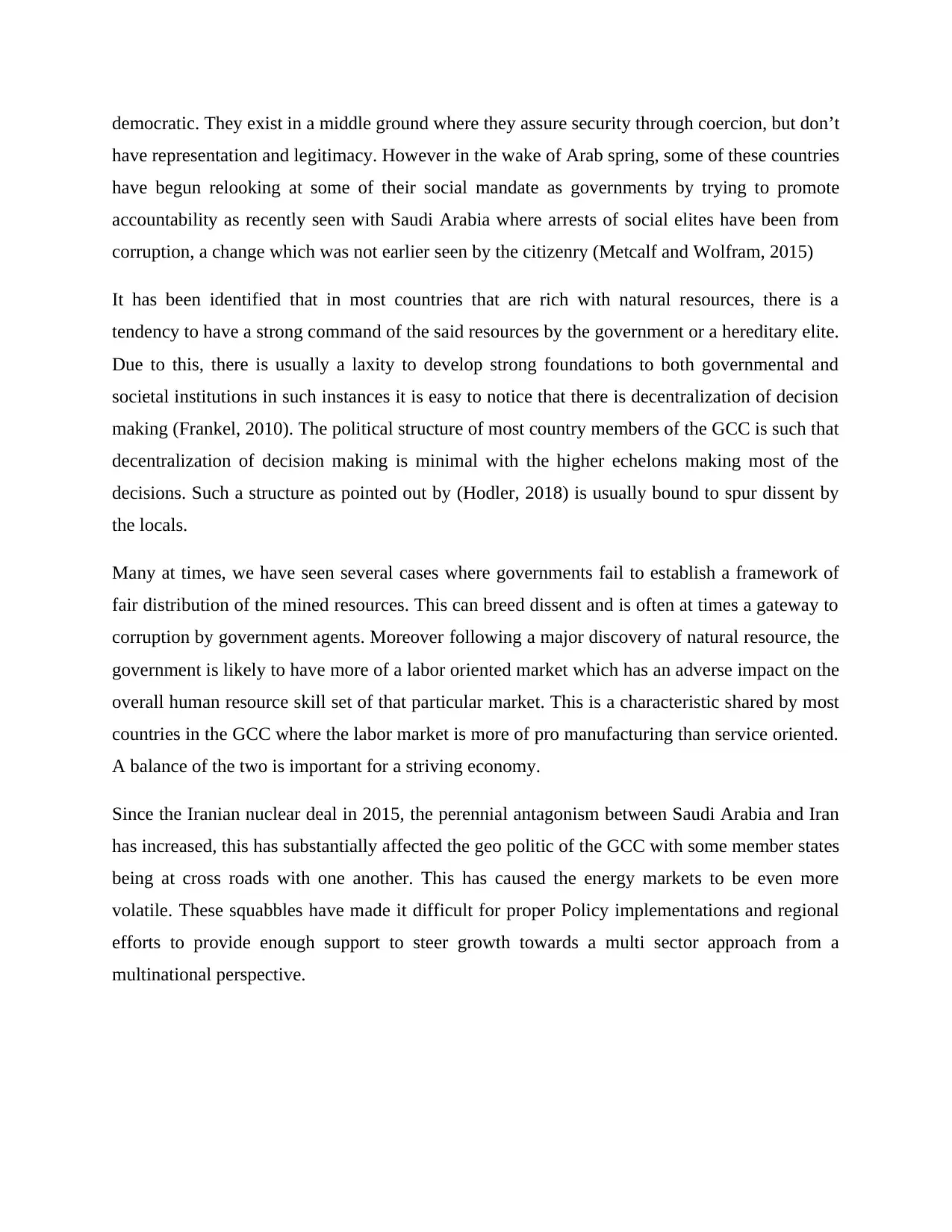
democratic. They exist in a middle ground where they assure security through coercion, but don’t
have representation and legitimacy. However in the wake of Arab spring, some of these countries
have begun relooking at some of their social mandate as governments by trying to promote
accountability as recently seen with Saudi Arabia where arrests of social elites have been from
corruption, a change which was not earlier seen by the citizenry (Metcalf and Wolfram, 2015)
It has been identified that in most countries that are rich with natural resources, there is a
tendency to have a strong command of the said resources by the government or a hereditary elite.
Due to this, there is usually a laxity to develop strong foundations to both governmental and
societal institutions in such instances it is easy to notice that there is decentralization of decision
making (Frankel, 2010). The political structure of most country members of the GCC is such that
decentralization of decision making is minimal with the higher echelons making most of the
decisions. Such a structure as pointed out by (Hodler, 2018) is usually bound to spur dissent by
the locals.
Many at times, we have seen several cases where governments fail to establish a framework of
fair distribution of the mined resources. This can breed dissent and is often at times a gateway to
corruption by government agents. Moreover following a major discovery of natural resource, the
government is likely to have more of a labor oriented market which has an adverse impact on the
overall human resource skill set of that particular market. This is a characteristic shared by most
countries in the GCC where the labor market is more of pro manufacturing than service oriented.
A balance of the two is important for a striving economy.
Since the Iranian nuclear deal in 2015, the perennial antagonism between Saudi Arabia and Iran
has increased, this has substantially affected the geo politic of the GCC with some member states
being at cross roads with one another. This has caused the energy markets to be even more
volatile. These squabbles have made it difficult for proper Policy implementations and regional
efforts to provide enough support to steer growth towards a multi sector approach from a
multinational perspective.
have representation and legitimacy. However in the wake of Arab spring, some of these countries
have begun relooking at some of their social mandate as governments by trying to promote
accountability as recently seen with Saudi Arabia where arrests of social elites have been from
corruption, a change which was not earlier seen by the citizenry (Metcalf and Wolfram, 2015)
It has been identified that in most countries that are rich with natural resources, there is a
tendency to have a strong command of the said resources by the government or a hereditary elite.
Due to this, there is usually a laxity to develop strong foundations to both governmental and
societal institutions in such instances it is easy to notice that there is decentralization of decision
making (Frankel, 2010). The political structure of most country members of the GCC is such that
decentralization of decision making is minimal with the higher echelons making most of the
decisions. Such a structure as pointed out by (Hodler, 2018) is usually bound to spur dissent by
the locals.
Many at times, we have seen several cases where governments fail to establish a framework of
fair distribution of the mined resources. This can breed dissent and is often at times a gateway to
corruption by government agents. Moreover following a major discovery of natural resource, the
government is likely to have more of a labor oriented market which has an adverse impact on the
overall human resource skill set of that particular market. This is a characteristic shared by most
countries in the GCC where the labor market is more of pro manufacturing than service oriented.
A balance of the two is important for a striving economy.
Since the Iranian nuclear deal in 2015, the perennial antagonism between Saudi Arabia and Iran
has increased, this has substantially affected the geo politic of the GCC with some member states
being at cross roads with one another. This has caused the energy markets to be even more
volatile. These squabbles have made it difficult for proper Policy implementations and regional
efforts to provide enough support to steer growth towards a multi sector approach from a
multinational perspective.
Secure Best Marks with AI Grader
Need help grading? Try our AI Grader for instant feedback on your assignments.
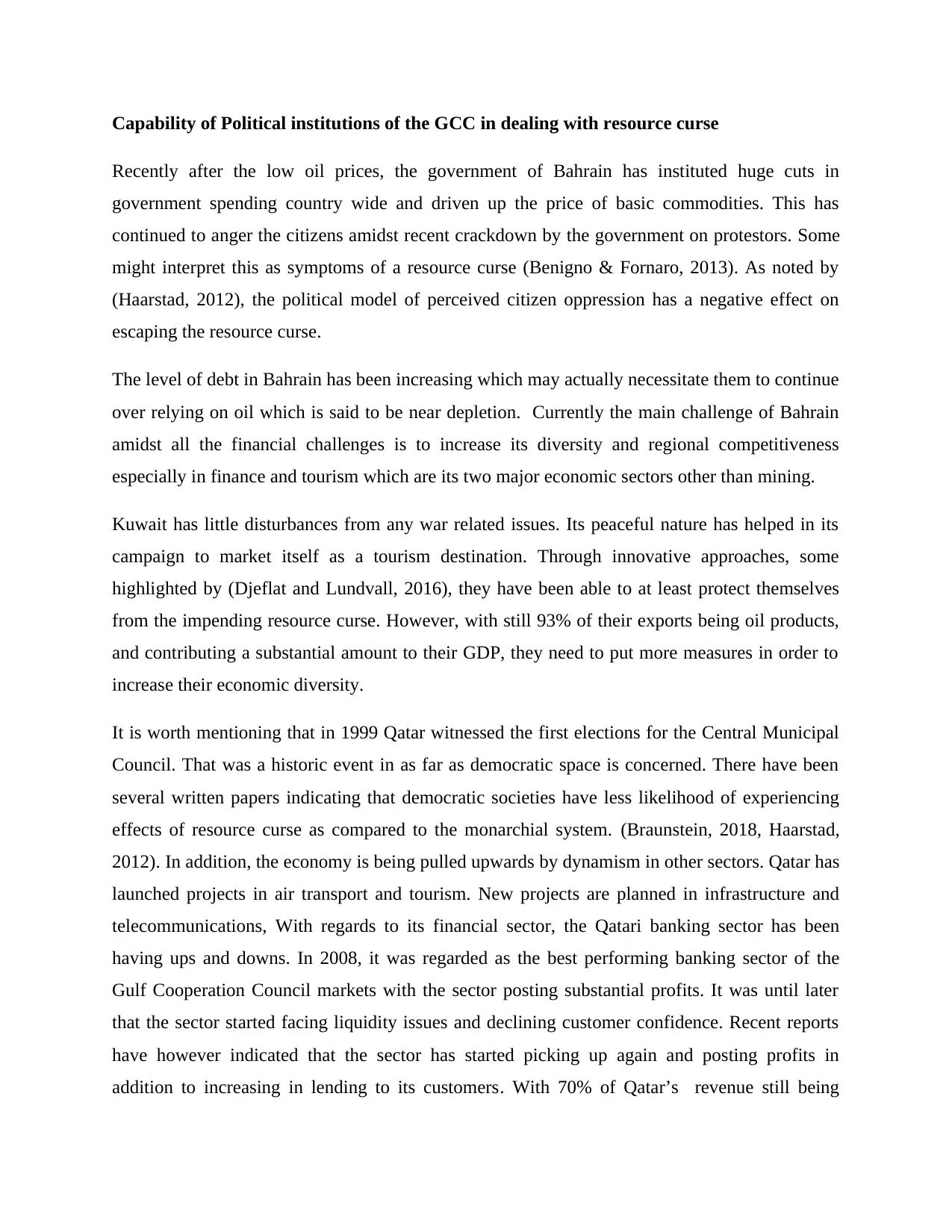
Capability of Political institutions of the GCC in dealing with resource curse
Recently after the low oil prices, the government of Bahrain has instituted huge cuts in
government spending country wide and driven up the price of basic commodities. This has
continued to anger the citizens amidst recent crackdown by the government on protestors. Some
might interpret this as symptoms of a resource curse (Benigno & Fornaro, 2013). As noted by
(Haarstad, 2012), the political model of perceived citizen oppression has a negative effect on
escaping the resource curse.
The level of debt in Bahrain has been increasing which may actually necessitate them to continue
over relying on oil which is said to be near depletion. Currently the main challenge of Bahrain
amidst all the financial challenges is to increase its diversity and regional competitiveness
especially in finance and tourism which are its two major economic sectors other than mining.
Kuwait has little disturbances from any war related issues. Its peaceful nature has helped in its
campaign to market itself as a tourism destination. Through innovative approaches, some
highlighted by (Djeflat and Lundvall, 2016), they have been able to at least protect themselves
from the impending resource curse. However, with still 93% of their exports being oil products,
and contributing a substantial amount to their GDP, they need to put more measures in order to
increase their economic diversity.
It is worth mentioning that in 1999 Qatar witnessed the first elections for the Central Municipal
Council. That was a historic event in as far as democratic space is concerned. There have been
several written papers indicating that democratic societies have less likelihood of experiencing
effects of resource curse as compared to the monarchial system. (Braunstein, 2018, Haarstad,
2012). In addition, the economy is being pulled upwards by dynamism in other sectors. Qatar has
launched projects in air transport and tourism. New projects are planned in infrastructure and
telecommunications, With regards to its financial sector, the Qatari banking sector has been
having ups and downs. In 2008, it was regarded as the best performing banking sector of the
Gulf Cooperation Council markets with the sector posting substantial profits. It was until later
that the sector started facing liquidity issues and declining customer confidence. Recent reports
have however indicated that the sector has started picking up again and posting profits in
addition to increasing in lending to its customers. With 70% of Qatar’s revenue still being
Recently after the low oil prices, the government of Bahrain has instituted huge cuts in
government spending country wide and driven up the price of basic commodities. This has
continued to anger the citizens amidst recent crackdown by the government on protestors. Some
might interpret this as symptoms of a resource curse (Benigno & Fornaro, 2013). As noted by
(Haarstad, 2012), the political model of perceived citizen oppression has a negative effect on
escaping the resource curse.
The level of debt in Bahrain has been increasing which may actually necessitate them to continue
over relying on oil which is said to be near depletion. Currently the main challenge of Bahrain
amidst all the financial challenges is to increase its diversity and regional competitiveness
especially in finance and tourism which are its two major economic sectors other than mining.
Kuwait has little disturbances from any war related issues. Its peaceful nature has helped in its
campaign to market itself as a tourism destination. Through innovative approaches, some
highlighted by (Djeflat and Lundvall, 2016), they have been able to at least protect themselves
from the impending resource curse. However, with still 93% of their exports being oil products,
and contributing a substantial amount to their GDP, they need to put more measures in order to
increase their economic diversity.
It is worth mentioning that in 1999 Qatar witnessed the first elections for the Central Municipal
Council. That was a historic event in as far as democratic space is concerned. There have been
several written papers indicating that democratic societies have less likelihood of experiencing
effects of resource curse as compared to the monarchial system. (Braunstein, 2018, Haarstad,
2012). In addition, the economy is being pulled upwards by dynamism in other sectors. Qatar has
launched projects in air transport and tourism. New projects are planned in infrastructure and
telecommunications, With regards to its financial sector, the Qatari banking sector has been
having ups and downs. In 2008, it was regarded as the best performing banking sector of the
Gulf Cooperation Council markets with the sector posting substantial profits. It was until later
that the sector started facing liquidity issues and declining customer confidence. Recent reports
have however indicated that the sector has started picking up again and posting profits in
addition to increasing in lending to its customers. With 70% of Qatar’s revenue still being
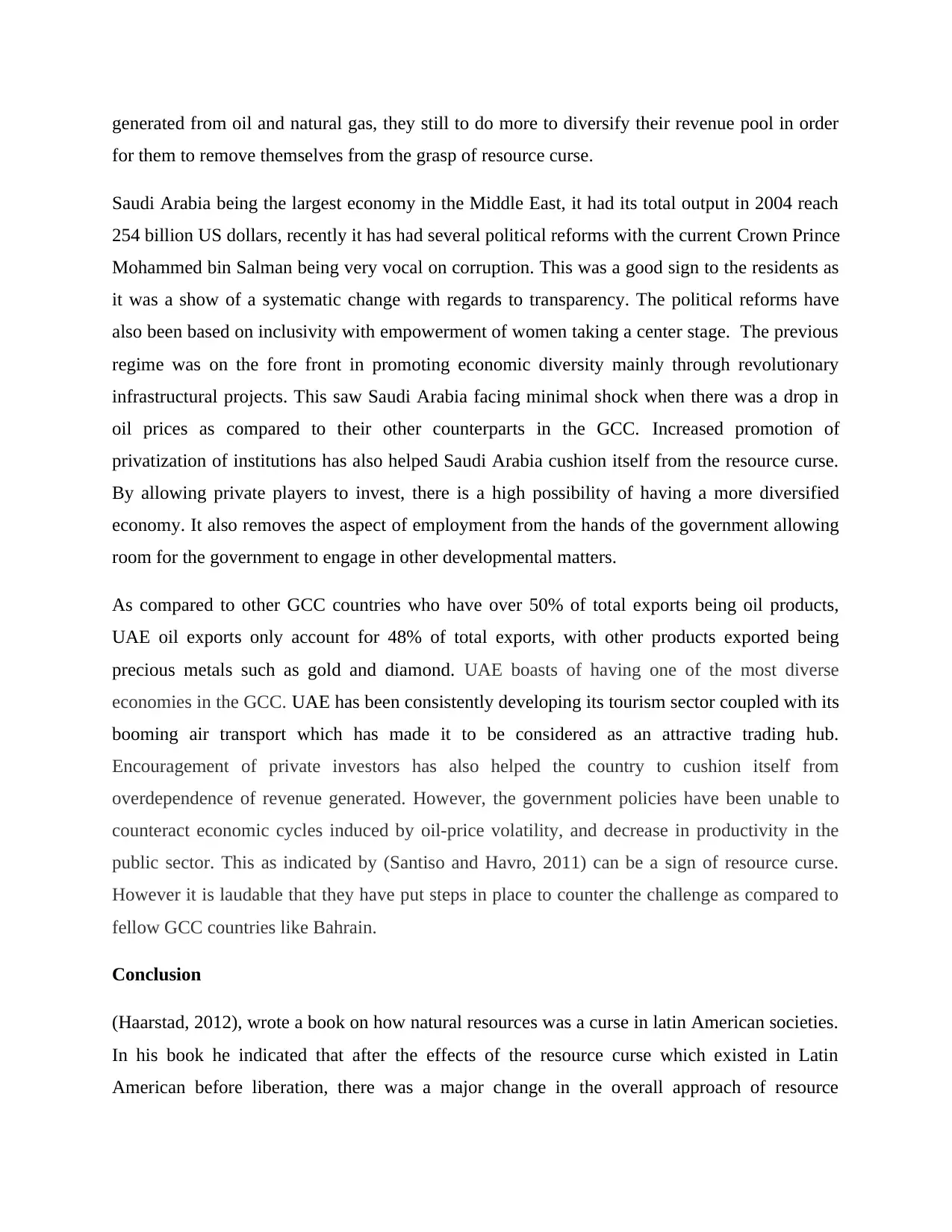
generated from oil and natural gas, they still to do more to diversify their revenue pool in order
for them to remove themselves from the grasp of resource curse.
Saudi Arabia being the largest economy in the Middle East, it had its total output in 2004 reach
254 billion US dollars, recently it has had several political reforms with the current Crown Prince
Mohammed bin Salman being very vocal on corruption. This was a good sign to the residents as
it was a show of a systematic change with regards to transparency. The political reforms have
also been based on inclusivity with empowerment of women taking a center stage. The previous
regime was on the fore front in promoting economic diversity mainly through revolutionary
infrastructural projects. This saw Saudi Arabia facing minimal shock when there was a drop in
oil prices as compared to their other counterparts in the GCC. Increased promotion of
privatization of institutions has also helped Saudi Arabia cushion itself from the resource curse.
By allowing private players to invest, there is a high possibility of having a more diversified
economy. It also removes the aspect of employment from the hands of the government allowing
room for the government to engage in other developmental matters.
As compared to other GCC countries who have over 50% of total exports being oil products,
UAE oil exports only account for 48% of total exports, with other products exported being
precious metals such as gold and diamond. UAE boasts of having one of the most diverse
economies in the GCC. UAE has been consistently developing its tourism sector coupled with its
booming air transport which has made it to be considered as an attractive trading hub.
Encouragement of private investors has also helped the country to cushion itself from
overdependence of revenue generated. However, the government policies have been unable to
counteract economic cycles induced by oil-price volatility, and decrease in productivity in the
public sector. This as indicated by (Santiso and Havro, 2011) can be a sign of resource curse.
However it is laudable that they have put steps in place to counter the challenge as compared to
fellow GCC countries like Bahrain.
Conclusion
(Haarstad, 2012), wrote a book on how natural resources was a curse in latin American societies.
In his book he indicated that after the effects of the resource curse which existed in Latin
American before liberation, there was a major change in the overall approach of resource
for them to remove themselves from the grasp of resource curse.
Saudi Arabia being the largest economy in the Middle East, it had its total output in 2004 reach
254 billion US dollars, recently it has had several political reforms with the current Crown Prince
Mohammed bin Salman being very vocal on corruption. This was a good sign to the residents as
it was a show of a systematic change with regards to transparency. The political reforms have
also been based on inclusivity with empowerment of women taking a center stage. The previous
regime was on the fore front in promoting economic diversity mainly through revolutionary
infrastructural projects. This saw Saudi Arabia facing minimal shock when there was a drop in
oil prices as compared to their other counterparts in the GCC. Increased promotion of
privatization of institutions has also helped Saudi Arabia cushion itself from the resource curse.
By allowing private players to invest, there is a high possibility of having a more diversified
economy. It also removes the aspect of employment from the hands of the government allowing
room for the government to engage in other developmental matters.
As compared to other GCC countries who have over 50% of total exports being oil products,
UAE oil exports only account for 48% of total exports, with other products exported being
precious metals such as gold and diamond. UAE boasts of having one of the most diverse
economies in the GCC. UAE has been consistently developing its tourism sector coupled with its
booming air transport which has made it to be considered as an attractive trading hub.
Encouragement of private investors has also helped the country to cushion itself from
overdependence of revenue generated. However, the government policies have been unable to
counteract economic cycles induced by oil-price volatility, and decrease in productivity in the
public sector. This as indicated by (Santiso and Havro, 2011) can be a sign of resource curse.
However it is laudable that they have put steps in place to counter the challenge as compared to
fellow GCC countries like Bahrain.
Conclusion
(Haarstad, 2012), wrote a book on how natural resources was a curse in latin American societies.
In his book he indicated that after the effects of the resource curse which existed in Latin
American before liberation, there was a major change in the overall approach of resource
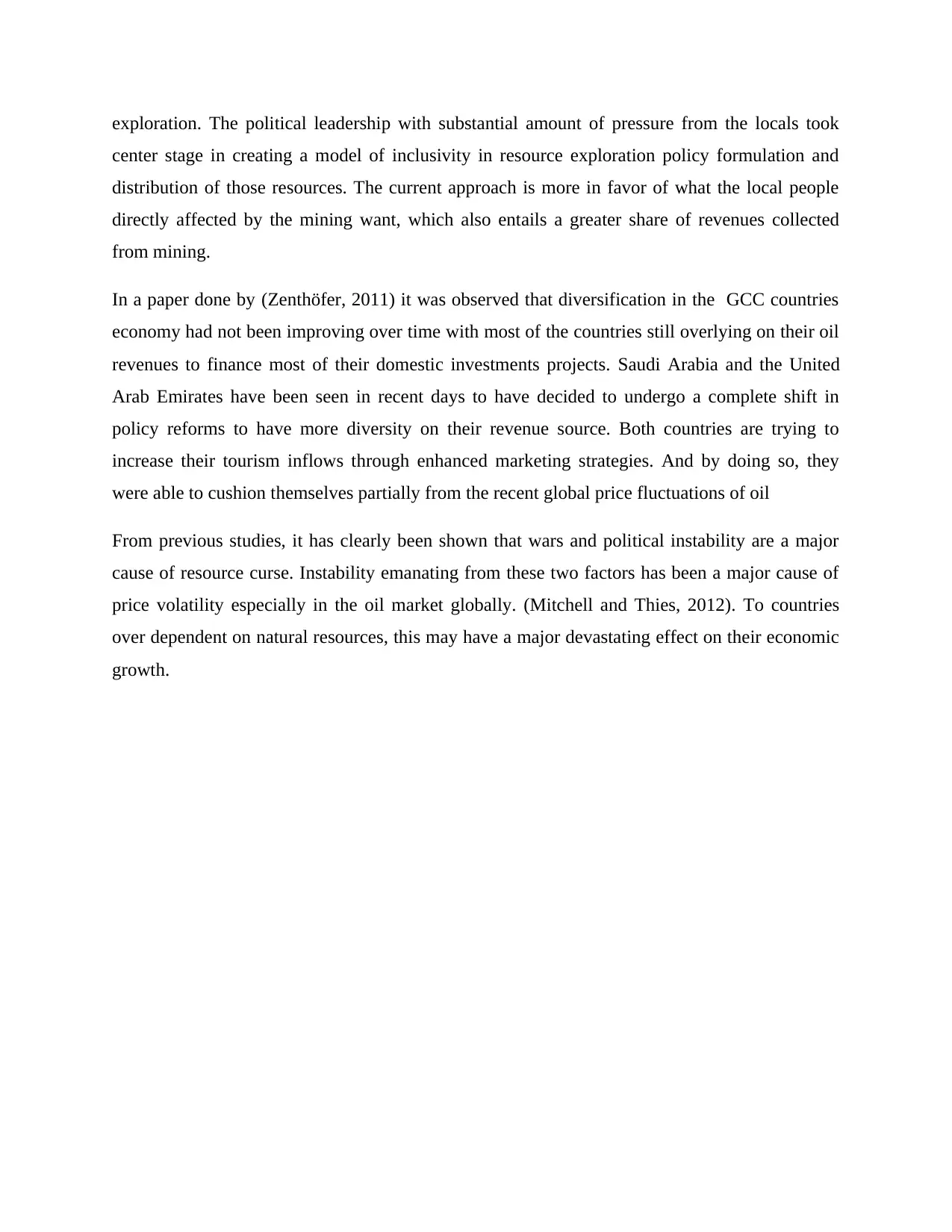
exploration. The political leadership with substantial amount of pressure from the locals took
center stage in creating a model of inclusivity in resource exploration policy formulation and
distribution of those resources. The current approach is more in favor of what the local people
directly affected by the mining want, which also entails a greater share of revenues collected
from mining.
In a paper done by (Zenthöfer, 2011) it was observed that diversification in the GCC countries
economy had not been improving over time with most of the countries still overlying on their oil
revenues to finance most of their domestic investments projects. Saudi Arabia and the United
Arab Emirates have been seen in recent days to have decided to undergo a complete shift in
policy reforms to have more diversity on their revenue source. Both countries are trying to
increase their tourism inflows through enhanced marketing strategies. And by doing so, they
were able to cushion themselves partially from the recent global price fluctuations of oil
From previous studies, it has clearly been shown that wars and political instability are a major
cause of resource curse. Instability emanating from these two factors has been a major cause of
price volatility especially in the oil market globally. (Mitchell and Thies, 2012). To countries
over dependent on natural resources, this may have a major devastating effect on their economic
growth.
center stage in creating a model of inclusivity in resource exploration policy formulation and
distribution of those resources. The current approach is more in favor of what the local people
directly affected by the mining want, which also entails a greater share of revenues collected
from mining.
In a paper done by (Zenthöfer, 2011) it was observed that diversification in the GCC countries
economy had not been improving over time with most of the countries still overlying on their oil
revenues to finance most of their domestic investments projects. Saudi Arabia and the United
Arab Emirates have been seen in recent days to have decided to undergo a complete shift in
policy reforms to have more diversity on their revenue source. Both countries are trying to
increase their tourism inflows through enhanced marketing strategies. And by doing so, they
were able to cushion themselves partially from the recent global price fluctuations of oil
From previous studies, it has clearly been shown that wars and political instability are a major
cause of resource curse. Instability emanating from these two factors has been a major cause of
price volatility especially in the oil market globally. (Mitchell and Thies, 2012). To countries
over dependent on natural resources, this may have a major devastating effect on their economic
growth.
Paraphrase This Document
Need a fresh take? Get an instant paraphrase of this document with our AI Paraphraser
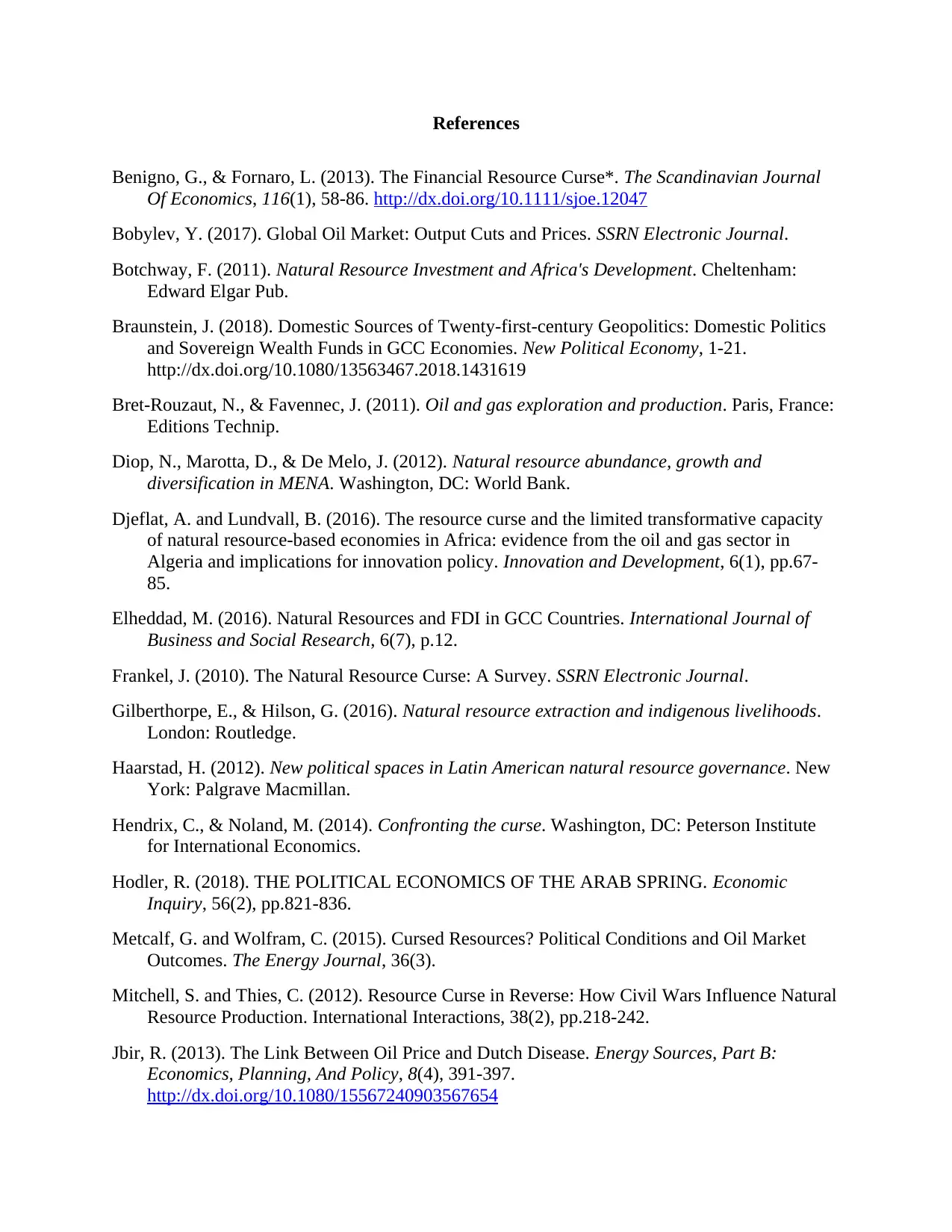
References
Benigno, G., & Fornaro, L. (2013). The Financial Resource Curse*. The Scandinavian Journal
Of Economics, 116(1), 58-86. http://dx.doi.org/10.1111/sjoe.12047
Bobylev, Y. (2017). Global Oil Market: Output Cuts and Prices. SSRN Electronic Journal.
Botchway, F. (2011). Natural Resource Investment and Africa's Development. Cheltenham:
Edward Elgar Pub.
Braunstein, J. (2018). Domestic Sources of Twenty-first-century Geopolitics: Domestic Politics
and Sovereign Wealth Funds in GCC Economies. New Political Economy, 1-21.
http://dx.doi.org/10.1080/13563467.2018.1431619
Bret-Rouzaut, N., & Favennec, J. (2011). Oil and gas exploration and production. Paris, France:
Editions Technip.
Diop, N., Marotta, D., & De Melo, J. (2012). Natural resource abundance, growth and
diversification in MENA. Washington, DC: World Bank.
Djeflat, A. and Lundvall, B. (2016). The resource curse and the limited transformative capacity
of natural resource-based economies in Africa: evidence from the oil and gas sector in
Algeria and implications for innovation policy. Innovation and Development, 6(1), pp.67-
85.
Elheddad, M. (2016). Natural Resources and FDI in GCC Countries. International Journal of
Business and Social Research, 6(7), p.12.
Frankel, J. (2010). The Natural Resource Curse: A Survey. SSRN Electronic Journal.
Gilberthorpe, E., & Hilson, G. (2016). Natural resource extraction and indigenous livelihoods.
London: Routledge.
Haarstad, H. (2012). New political spaces in Latin American natural resource governance. New
York: Palgrave Macmillan.
Hendrix, C., & Noland, M. (2014). Confronting the curse. Washington, DC: Peterson Institute
for International Economics.
Hodler, R. (2018). THE POLITICAL ECONOMICS OF THE ARAB SPRING. Economic
Inquiry, 56(2), pp.821-836.
Metcalf, G. and Wolfram, C. (2015). Cursed Resources? Political Conditions and Oil Market
Outcomes. The Energy Journal, 36(3).
Mitchell, S. and Thies, C. (2012). Resource Curse in Reverse: How Civil Wars Influence Natural
Resource Production. International Interactions, 38(2), pp.218-242.
Jbir, R. (2013). The Link Between Oil Price and Dutch Disease. Energy Sources, Part B:
Economics, Planning, And Policy, 8(4), 391-397.
http://dx.doi.org/10.1080/15567240903567654
Benigno, G., & Fornaro, L. (2013). The Financial Resource Curse*. The Scandinavian Journal
Of Economics, 116(1), 58-86. http://dx.doi.org/10.1111/sjoe.12047
Bobylev, Y. (2017). Global Oil Market: Output Cuts and Prices. SSRN Electronic Journal.
Botchway, F. (2011). Natural Resource Investment and Africa's Development. Cheltenham:
Edward Elgar Pub.
Braunstein, J. (2018). Domestic Sources of Twenty-first-century Geopolitics: Domestic Politics
and Sovereign Wealth Funds in GCC Economies. New Political Economy, 1-21.
http://dx.doi.org/10.1080/13563467.2018.1431619
Bret-Rouzaut, N., & Favennec, J. (2011). Oil and gas exploration and production. Paris, France:
Editions Technip.
Diop, N., Marotta, D., & De Melo, J. (2012). Natural resource abundance, growth and
diversification in MENA. Washington, DC: World Bank.
Djeflat, A. and Lundvall, B. (2016). The resource curse and the limited transformative capacity
of natural resource-based economies in Africa: evidence from the oil and gas sector in
Algeria and implications for innovation policy. Innovation and Development, 6(1), pp.67-
85.
Elheddad, M. (2016). Natural Resources and FDI in GCC Countries. International Journal of
Business and Social Research, 6(7), p.12.
Frankel, J. (2010). The Natural Resource Curse: A Survey. SSRN Electronic Journal.
Gilberthorpe, E., & Hilson, G. (2016). Natural resource extraction and indigenous livelihoods.
London: Routledge.
Haarstad, H. (2012). New political spaces in Latin American natural resource governance. New
York: Palgrave Macmillan.
Hendrix, C., & Noland, M. (2014). Confronting the curse. Washington, DC: Peterson Institute
for International Economics.
Hodler, R. (2018). THE POLITICAL ECONOMICS OF THE ARAB SPRING. Economic
Inquiry, 56(2), pp.821-836.
Metcalf, G. and Wolfram, C. (2015). Cursed Resources? Political Conditions and Oil Market
Outcomes. The Energy Journal, 36(3).
Mitchell, S. and Thies, C. (2012). Resource Curse in Reverse: How Civil Wars Influence Natural
Resource Production. International Interactions, 38(2), pp.218-242.
Jbir, R. (2013). The Link Between Oil Price and Dutch Disease. Energy Sources, Part B:
Economics, Planning, And Policy, 8(4), 391-397.
http://dx.doi.org/10.1080/15567240903567654
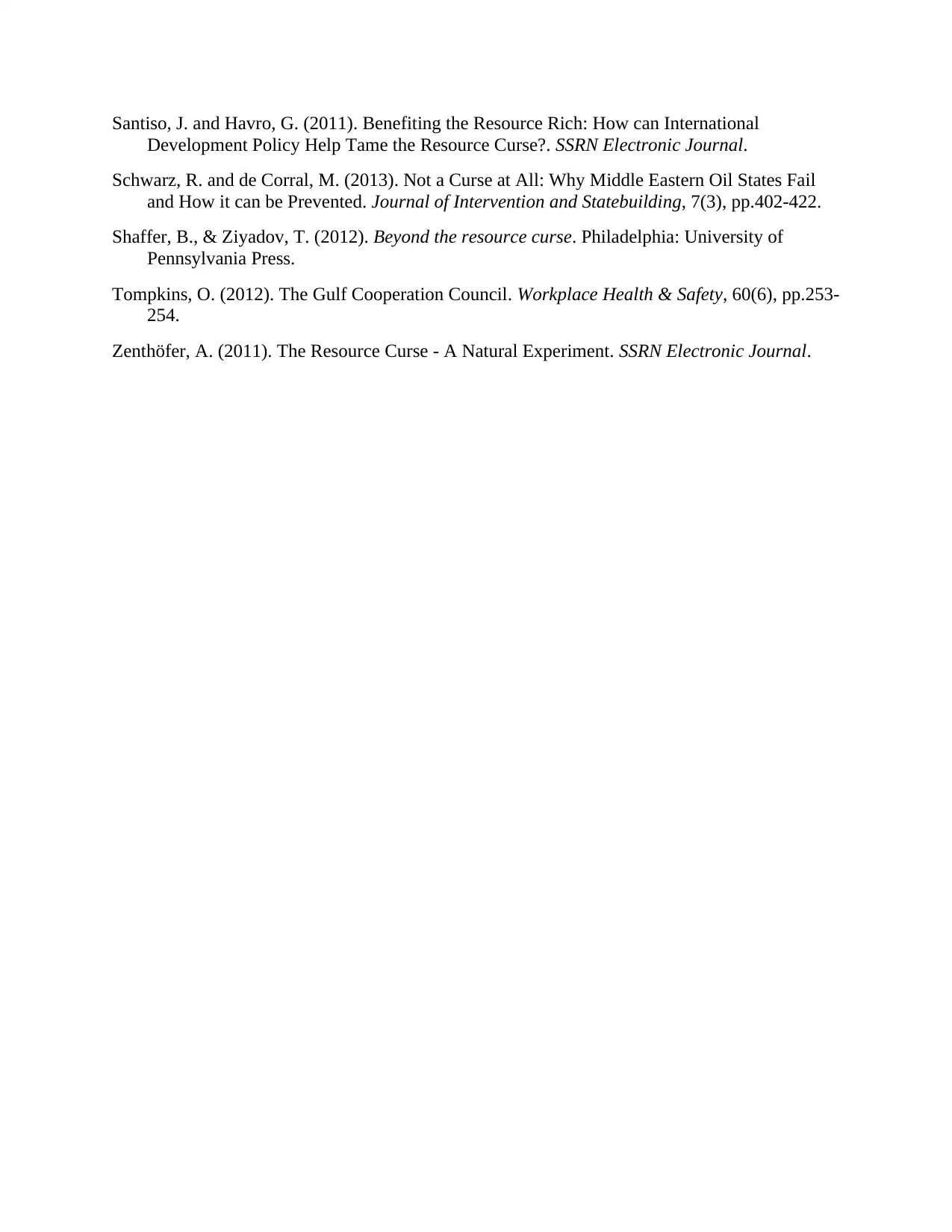
Santiso, J. and Havro, G. (2011). Benefiting the Resource Rich: How can International
Development Policy Help Tame the Resource Curse?. SSRN Electronic Journal.
Schwarz, R. and de Corral, M. (2013). Not a Curse at All: Why Middle Eastern Oil States Fail
and How it can be Prevented. Journal of Intervention and Statebuilding, 7(3), pp.402-422.
Shaffer, B., & Ziyadov, T. (2012). Beyond the resource curse. Philadelphia: University of
Pennsylvania Press.
Tompkins, O. (2012). The Gulf Cooperation Council. Workplace Health & Safety, 60(6), pp.253-
254.
Zenthöfer, A. (2011). The Resource Curse - A Natural Experiment. SSRN Electronic Journal.
Development Policy Help Tame the Resource Curse?. SSRN Electronic Journal.
Schwarz, R. and de Corral, M. (2013). Not a Curse at All: Why Middle Eastern Oil States Fail
and How it can be Prevented. Journal of Intervention and Statebuilding, 7(3), pp.402-422.
Shaffer, B., & Ziyadov, T. (2012). Beyond the resource curse. Philadelphia: University of
Pennsylvania Press.
Tompkins, O. (2012). The Gulf Cooperation Council. Workplace Health & Safety, 60(6), pp.253-
254.
Zenthöfer, A. (2011). The Resource Curse - A Natural Experiment. SSRN Electronic Journal.
1 out of 9
Related Documents
Your All-in-One AI-Powered Toolkit for Academic Success.
+13062052269
info@desklib.com
Available 24*7 on WhatsApp / Email
![[object Object]](/_next/static/media/star-bottom.7253800d.svg)
Unlock your academic potential
© 2024 | Zucol Services PVT LTD | All rights reserved.





